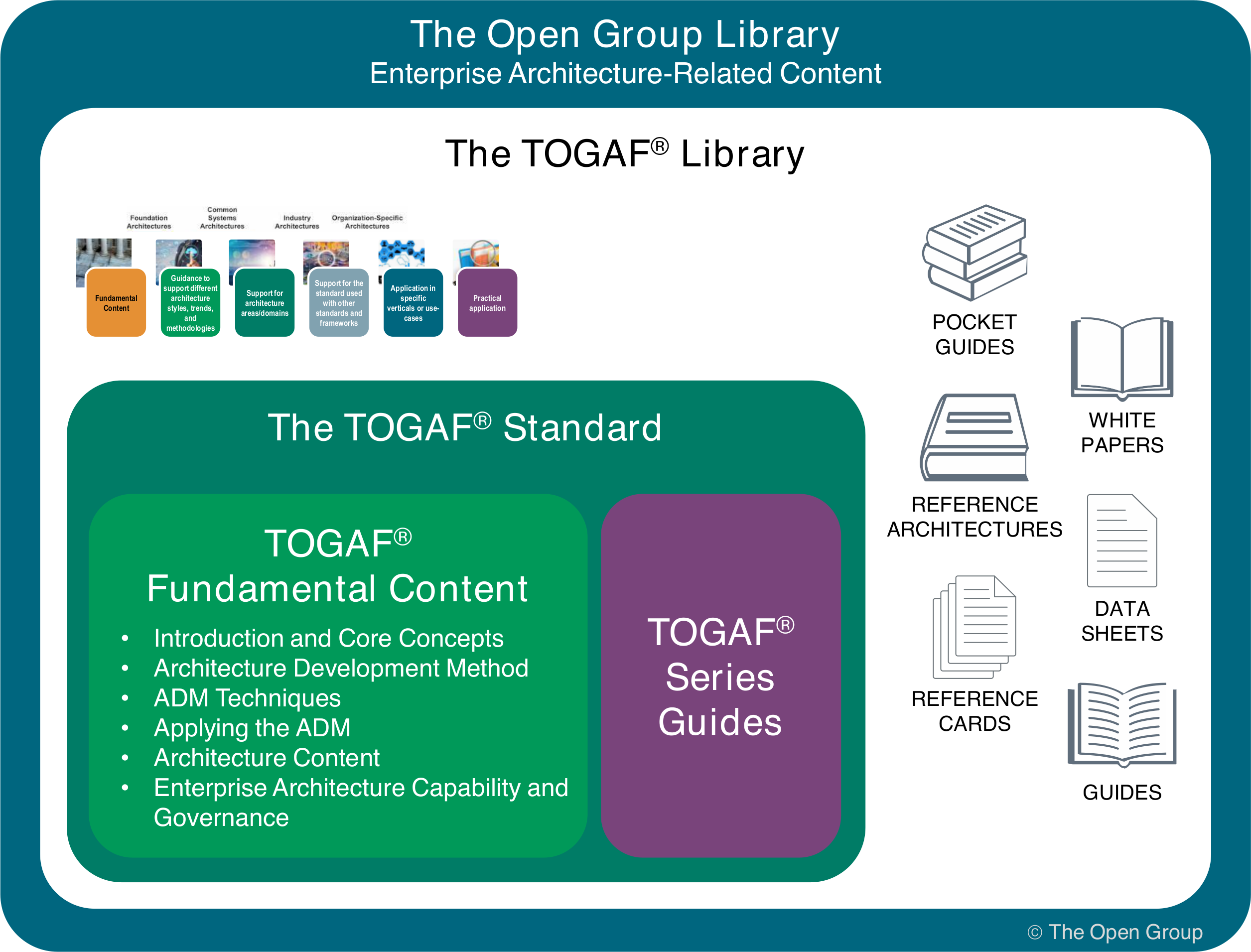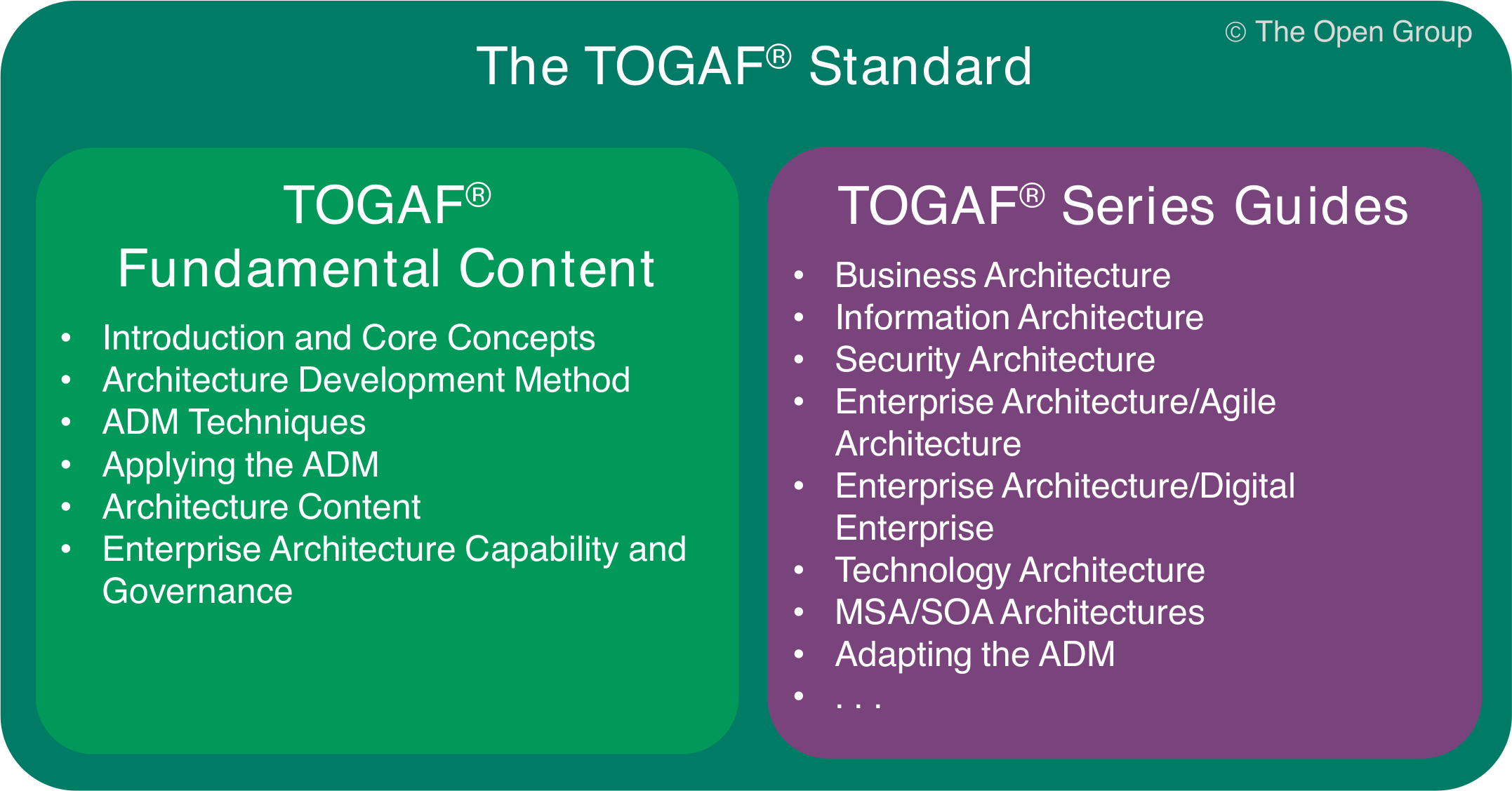2. The TOGAF Documentation Set
2.1 Structure of the TOGAF Documentation Set
The TOGAF documentation set consists of a portfolio of documents illustrated in Figure 2-1 .

The TOGAF Standard
The TOGAF Standard describes the generally applicable approach to Enterprise and IT Architecture. It is presented as a series of free-standing, but closely linked documents, as shown in Figure 2-1 .
The TOGAF Standard is a standard of The Open Group. The Open Group works with customers and suppliers of technology products and services, and with consortia and other standards organizations to capture, clarify, and integrate current and emerging requirements, establish standards and policies, and share best practices. Standards ensure openness, interoperability, and consensus.
The TOGAF Library
The TOGAF Library is a portfolio of additional guidance material, which supports the practical application of the TOGAF approach.
2.2 The TOGAF Standard
The TOGAF Standard is an open, industry consensus framework for Enterprise Architecture.
It is a foundational framework, which means that it is applicable to the development of any kind of architecture in any context. This foundational framework is supplemented by The Open Group TOGAF Library, an extensive and growing portfolio of guidance material, providing practical guidance in the application of the TOGAF framework in specific contexts.
The structure of the TOGAF Standard reflects the structure and content of an Architecture Capability within an enterprise, as shown in Figure 2-2 .

The TOGAF Standard Fundamental Content is presented as six free-standing documents:
- The TOGAF Standard — Introduction and Core Concepts (this document)
- The TOGAF Standard — Architecture Development Method
This document describes the TOGAF Architecture Development Method (ADM) — an iterative approach to developing an Enterprise Architecture.
- The TOGAF Standard — ADM Techniques
This document contains a collection of techniques available for use in applying the TOGAF approach and the TOGAF ADM.
- The TOGAF Standard — Applying the ADM
This document contains guidelines for adapting the TOGAF ADM to address the specific style of architecture required in a practical context.
- The TOGAF Standard — Architecture Content
This document describes the TOGAF Content Framework and a structured metamodel for architectural artifacts, the use of re-usable Architecture Building Blocks (ABBs), and an overview of typical architecture deliverables.
- The TOGAF Standard — EA Capability and Governance
This document discusses the organization, processes, skills, roles, and responsibilities required to establish and operate an architecture function within an enterprise and describes an Enterprise Architecture governance framework.
The intention of dividing the TOGAF Standard into these independent documents is to allow for different areas of specialization to be considered in detail and potentially addressed in isolation. Although all the constituent documents work together as a whole, it is also feasible to select particular documents for adoption while excluding others. For example, an organization may wish to adopt the ADM process, but elect not to use any of the materials relating to Architecture Capability. As an open framework, such use is encouraged, particularly in the following situations:
- Organizations that are new to the TOGAF approach and wish to incrementally adopt TOGAF concepts are expected to focus on particular constituent documents of the standard for initial adoption, with other areas tabled for later consideration
- Organizations that have already deployed architecture frameworks may choose to merge these frameworks with aspects of the TOGAF Standard
The TOGAF Standard comprises the TOGAF Fundamental Content and a collection of TOGAF Series Guides, which provide the practical guidance in the application of the TOGAF Standard.
Figure 2-3 depicts the structure and scope of the TOGAF Standard.

Besides the core framework content covered by the six documents explained above, the standard provides guidance to address specific concerns and use-cases through the TOGAF Series Guides.
The TOGAF Series Guides are designed to support more specific needs from practitioners who need further explanation or more detail than that provided in the core content.
Not all the TOGAF Series Guides will be relevant in every situation. However, Enterprise Architects who are planning the deployment of the TOGAF Standard should be aware of the guidance available.
This content will evolve more rapidly than the core content to cover new needs as they emerge from market trends and the needs of the industry. There is a set of activities running continuously in The Open Group Architecture Forum to deliver this content following a continuous and incremental delivery pipeline.
Examples of the areas covered by this guidance material are:
- Strategy decision-making and business value-oriented decisions
- Business Architecture and operating model description
- Information and data management
- Information system guidance
- Information reference models and data integration models
- Technology Architecture: how Enterprise Architecture as a practice can be applied to adopt new technology trends to assess if the organization owns the right capabilities to support the new technology adoption
- Security Architecture: how the TOGAF Standard can be applied to deliver and support Security Architecture and risk management
- How Enterprise Architecture as a practice and the TOGAF Standard can be applied to support the agile enterprise, to be delivered following an agile style, and how the standard can support organizations using agile methodologies
- How Enterprise Architecture as a practice and the TOGAF Standard support the digital enterprise so that organizations can deliver digital products, and improve their digital offering and digital value proposition
- How the standard can be applied with other standards and methodologies of The Open Group such as the O-AATM Standard, the DPBoKTM Standard, the IT4ITTM Reference Architecture, the ArchiMate® Specification, Microservices Architecture (MSA), security standards, and also with other standards bodies' standards and best practices
The complete set of TOGAF Series Guides can be found at www.opengroup.org/library/guides/togaf/togaf-series-guides.
2.3 The TOGAF Library
Accompanying the TOGAF Standard is a broad portfolio of guidance material, known as the TOGAF Library,1 to support the practical application of the TOGAF approach. The TOGAF Library is a reference library containing guidelines, templates, patterns, and other forms of reference material to accelerate the creation of new architectures for the enterprise.
The TOGAF Library is maintained under the governance of The Open Group Architecture Forum.
The TOGAF Library supports one of the classes of information in the TOGAF Enterprise Architecture Repository, the Reference Library.
The Reference Library provides guidelines, templates, patterns, and other forms of reference material that can be leveraged in order to accelerate the creation of new architectures for the enterprise.
The TOGAF Library is a Reference Library of potentially useful resources. The TOGAF Library follows a categorization model based on capabilities and features that can be delivered into the market through different sets of documents and resources, as depicted in Figure 2-4 .

Footnotes
1. The TOGAF Library is a publicly accessible resource located at www.opengroup.org/togaf-library.
TOGAF is a registered trademark of The Open Group
 return to top of page
return to top of page